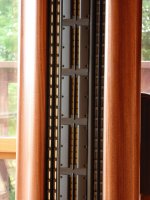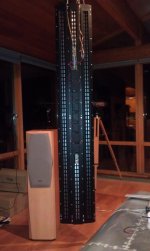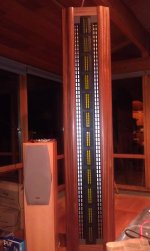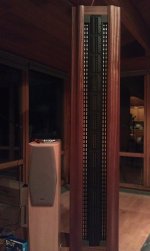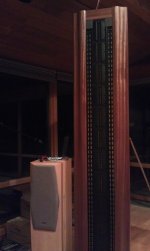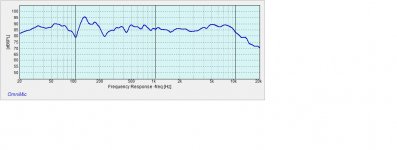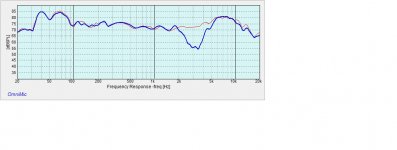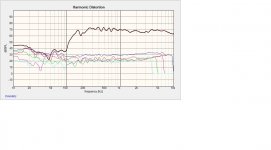My speaker project finally got to the point where I can stand one of them up in the frame. There are two midrange line sources (BG RD75) on the outsides and a line of twelve tweeters in the middle (Dayton Audio PT2C-8) . The tweeters were just balanced there and were taken right out before they fell. The millwork on the sides are mahogany bar railings, which have a useful contour acoustically.
https://www.flickr.com/photos/rad123/sets/72157653010700971/with/17177942213/
Made a little jig to plane 4.5mm off of each end of the tweeters. Looks nicer having them squared off when they are in an array and they are a little closer.
https://www.flickr.com/photos/rad123/sets/72157653010700971/with/17177942213/
Made a little jig to plane 4.5mm off of each end of the tweeters. Looks nicer having them squared off when they are in an array and they are a little closer.
Attachments
Clean work and would like to know how your going to address the crossover and cancelation effects at the listening position?
Regards
David
Regards
David
Hi David:
They are meant to be listened to on axis, toed in.
I use electronic crossovers so I can time align the drivers.
With the mock up's there was no problem with drop out at the crossover frequency. I didn't measure off axis.
Not sure if I answered your question.
I tried different configurations and have been listening to the mock up's in the attached picture. Sound so good sucked my motivation and I've been listening to them for maybe 9 months. The middle RD75 is only used as a convenient spacer currently, not powered.
One of the configurations was the 3 RD75s with only the middle one getting high frequencies. I just couldn't get the RD75's to sound right on their own even with equalization.
I have enough Neo 3's for a full length tweeter array but I'm planning on using them with a line array of Neo 10's. First I have to build a separate mid bass diplole line source and 18 inch dipole woofers.
I'm building a series of speakers to listen to imaging characteristics in different configurations. I was disappointed, to say the least, when BG stopped selling drivers.
They are meant to be listened to on axis, toed in.
I use electronic crossovers so I can time align the drivers.
With the mock up's there was no problem with drop out at the crossover frequency. I didn't measure off axis.
Not sure if I answered your question.
I tried different configurations and have been listening to the mock up's in the attached picture. Sound so good sucked my motivation and I've been listening to them for maybe 9 months. The middle RD75 is only used as a convenient spacer currently, not powered.
One of the configurations was the 3 RD75s with only the middle one getting high frequencies. I just couldn't get the RD75's to sound right on their own even with equalization.
I have enough Neo 3's for a full length tweeter array but I'm planning on using them with a line array of Neo 10's. First I have to build a separate mid bass diplole line source and 18 inch dipole woofers.
I'm building a series of speakers to listen to imaging characteristics in different configurations. I was disappointed, to say the least, when BG stopped selling drivers.
Attachments
As beautiful as could be.
Can you post measurements made at the listener's position, please? Don't be shy, all our curves at listener's position look awful. I'm esp. interested in OB lower freq performance.
Many theoretical advances from a line source OB. Thinking of stacking 5 Dayton-Wright 18-inch cells.
Ben
Can you post measurements made at the listener's position, please? Don't be shy, all our curves at listener's position look awful. I'm esp. interested in OB lower freq performance.
Many theoretical advances from a line source OB. Thinking of stacking 5 Dayton-Wright 18-inch cells.
Ben
I'll do that.
With the two BG75's I was thinking that I would have enough low frequency extension to bridge over to a dipole array of mid bass drivers.
It's an ongoing experiment so I will post as I have more data.
I have been out of the hobby for 20 years. I had significant financial limitations then and it was hard to feed my speaker building obsession. I helped someone build a pair of dipoles with a line array of 10$, square "full-range" clear plastic drivers. Much to my surprise the imaging was sometimes much better than what I'd built with about 2K worth of drivers, accuton midranges and dynaudio woofers, and no name tweeters. That led to an interest in electrostatic drivers, which is what I was listening to when my training program got in the way.
So at the beginning of the experiments I am building a relatively narrow dipole line source. I plan on building some curved line sources with BG Neo3's and BG Neo10's and eventually some electrostatics again.
With the two BG75's I was thinking that I would have enough low frequency extension to bridge over to a dipole array of mid bass drivers.
It's an ongoing experiment so I will post as I have more data.
I have been out of the hobby for 20 years. I had significant financial limitations then and it was hard to feed my speaker building obsession. I helped someone build a pair of dipoles with a line array of 10$, square "full-range" clear plastic drivers. Much to my surprise the imaging was sometimes much better than what I'd built with about 2K worth of drivers, accuton midranges and dynaudio woofers, and no name tweeters. That led to an interest in electrostatic drivers, which is what I was listening to when my training program got in the way.
So at the beginning of the experiments I am building a relatively narrow dipole line source. I plan on building some curved line sources with BG Neo3's and BG Neo10's and eventually some electrostatics again.
Using the omnimic.
Speakers 8ft away at the listening position. Played a a level that would be loud for listening to music for me.
At 90Hz my old infinities providing the bass the THD is 2.8%
In the midrange at 800 Hz THD almost all second at 0.66%.
at 700 Hz a peak in the 3rd harmonic gets up to 0.1%.
At 2.5Khz THD 0.22%
with 2nd being 0.17% an third 0.07%
Speakers 8ft away at the listening position. Played a a level that would be loud for listening to music for me.
At 90Hz my old infinities providing the bass the THD is 2.8%
In the midrange at 800 Hz THD almost all second at 0.66%.
at 700 Hz a peak in the 3rd harmonic gets up to 0.1%.
At 2.5Khz THD 0.22%
with 2nd being 0.17% an third 0.07%
Attachments
Frequency response at the listening position without equalization at 1/12th octave smoothing.
Looking for lobing at about 30 degrees with a graph at 0 and 30 degrees.
The frequency response of the midrange alone. The harmonic distortion graphs aren't accurate. Took them before I realized I was picking up noise from the air filter in the lower level. Turned it off before the graph above.
Looking for lobing at about 30 degrees with a graph at 0 and 30 degrees.
The frequency response of the midrange alone. The harmonic distortion graphs aren't accurate. Took them before I realized I was picking up noise from the air filter in the lower level. Turned it off before the graph above.
Attachments
Very impressive results. Thanks for posting.
(I suppose the THD in post #9 would be a bit north of the 2nd and 3rd harmonic curves.... but all quite low.)
These are useful measurements. Loudness defined relative to ordinary seat and listening level. Mic at seat. The way I like to do it.
A buddy has been urging me to make a line-source using a bunch of my 8 W x 18 H inch ESL panels, stacked to the ceiling, 130 Hz and up. I get really really fine results when mounted in a panel, 3 cells wide and 2 cells high (total is 6 cells per panel).
A line source would allow only 5 cells per side and might not be capable of the loudness I'd like.
Ben
(I suppose the THD in post #9 would be a bit north of the 2nd and 3rd harmonic curves.... but all quite low.)
These are useful measurements. Loudness defined relative to ordinary seat and listening level. Mic at seat. The way I like to do it.
A buddy has been urging me to make a line-source using a bunch of my 8 W x 18 H inch ESL panels, stacked to the ceiling, 130 Hz and up. I get really really fine results when mounted in a panel, 3 cells wide and 2 cells high (total is 6 cells per panel).
A line source would allow only 5 cells per side and might not be capable of the loudness I'd like.
Ben
Last edited:
- Status
- Not open for further replies.
- Home
- Loudspeakers
- Planars & Exotics
- Line source build
